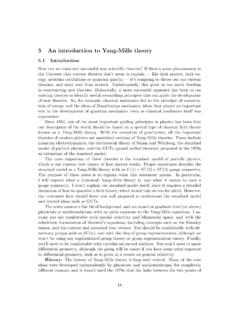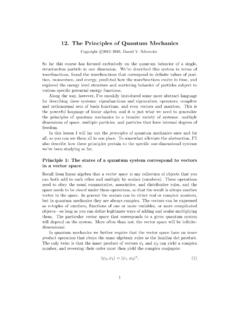Transcription of Quantum Mechanics I: Basic Principles - Michael Nielsen
1 Quantum Mechanics I: Basic PrinciplesMichael A. NielsenUniversity of Queensland I ain t no physicist but I know what matters -Popeye the SailorGoal of this and the next lecture: to introduce all the Basic elements of Quantum Mechanics , using examples drawn from Quantum information is Quantum Mechanics ?It is a frameworkfor the development of physical is nota complete physical theory in its own systemApplications softwareQuantum electrodynamics (QED) Quantum mechanicsSpecific rulesNewton s laws of motionNewtonian gravitationQM consists of four mathematical postulateswhich lay theground rules for our description of the successful is Quantum Mechanics ?It is just for the small stuff!QM crucial to explain why stars shine, how the Universeformed, and the stability of deviations from Quantum Mechanics are knownMost physicists believe that any theory of everything will be a Quantum mechanical theoryA conceptual issue, the so-called measurement problem , remains to be clarified.
2 Attempts to describe gravitation in the framework of Quantum Mechanics have (so far) structure of Quantum mechanicslinear algebra,,A Diracnotation4 postulates ofquantum mechanics1. How to describe Quantum states of a closed How to describe Quantum dynamics. state vectors and state space 3. How to describe measurements of a Quantum system. unitary evolution projective measurements 4. How to describe Quantum state of a composite system. tensor products Example: qubits(two-level Quantum systems)01 +01 +=22||||1 Normalization 0 and 1 are thecomputational basis statesphotonselectron spinnuclear spinetcetera All we do is draw little arrows on a piece of paper -that's all. -Richard FeynmanPostulate 1: Rough FormAssociated to any Quantum system is a complex vector space known as state stateof a closed Quantum system is a unit vector instate space. Example: we ll work mainly with qubits, which have statespace + Quantum Mechanics does notprescribe the state spacesof specific systems, such as electrons.
3 That s the job ofa physical theory like Quantum few conventions(= ) GWe write vectors in state space as: This is the alwaysassume that our physical systems have finite-dimensionalstate :ddd =++++ = QuditdCDynamics: Quantum logic gatesQuantum not gate:XInput qubitOutput qubit01; + 01?0 101 0110X = + +0110 General dynamics of a closed Quantum system(including logic gates) can be represented as aunitary representation:Unitary matricesabAcd = Hermitianconjugation; taking the adjoint() *TAA=**acbd = Ais said to be unitaryifAA AAI==We usually write unitary matrices as U. Example: 010110XX101001I === Nomenclature tipsmatrix=(linear) operator=(linear) transformation=(linear) map= Quantum gate (modulo unitarity)Postulate 2 The of a is describedevolutionclosed Quantum systemunitary transforma by a tion.'U =Why unitaries?Unitary maps are the only linear maps that preservenormalization.'U =implies '1U ===Exercise:prove that unitary evolution preserves gates1 gate (AKA or )xX 0101; X10; X10X === X2Y gate (AKA or )y Y001; Y10; Y0iYiii == = 3Z gate (AKA or )z Z0 Notation: I 1000; Z11; Z01Z == = Exercise:prove that XY=iZExercise:prove that X2=Y2=Z2=IMeasuring a qubit: a rough and ready prescription01 =+ Quantum Mechanics DOES NOT allow us to determine and.
4 We can, however, read out limited information about and . Measuring in the computational basis 22(0); (1)PP ==Measurement the system, leaving it in a state 0 or 1 determiunavoidably disned by the a qubit10110122 1(0)(1)2PP==More general measurements1 Let ,.., be an orthonormal basis for .ddeeC12A gives re"measuremenst of in the basis ,..,"(ult with probability .) djjeePje = **Reminder: + Measurement the system, leaving it in a state deterunavoidablmined by ty dhe example01 =+0101 Introduce orthonormal basis 22+ += =()211Pr+=12 22 +=2=2 +2Pr()2 =Inner products and duals Young man, in mathematics you don t understandthings, you just get used to them. -John von NeumannThe inner product is used to define the of a vectodualr . ()If lives in then the of is a function defined bduya: l ddCCC Example:()1001=0 += Simplified notation: ()()()()** Properties: , since ,, , since ,,abbaabbaAbbAAbcbAcbAc== ==Duals as row vectors()*Suppose = and =.
5 Then ,jjjjjjjaajbbjababab== 1**122baab = ..#**12identificatThis suggests the very useful of withthe row vector .ionaaa ..Postulate 3: rough form12If we measure in an orthonormal basis ,..,, then we obtain the result with probability ).( jdPjejee =The measurement the system, leaving it in a state determined by thedis measurement problemQuantum systemMeasuring apparatusRest of the UniversePostulates 1 and 2 Postulate 3 Research problem:solve the measurement of global phase 12 Suppose we measure in the orthonormal basis ,..,.Pr(Then ).djeeje =212 Suppose we measure in the orthonormal basis ,..,.Then Pr).( idijjjeeeeee ==global phase factor unobservabThe is thus , and we mayidentify the states and .leiiee Revised postulate 1 Associated to any Quantum system is a complex inner product spaceknown as state space. The state of a closed Quantum system is a unit vectorin state space. Note: These inner product spaces are often calledHilbert spaces.
6 Multiple-qubit systems0001101100011011 +++Measurement in the computational basis: =2(,)||xyPxy{} 0,1nxxxGeneral state of nqubits:()Classically, requires 2 bits to describe the Hilbert space is a big place -Carlton Caves Perhaps [..] we need a mathematical theory of quantumautomata. [..] the Quantum state space has far greatercapacity than the classical one: [..] in the Quantum casewe get the exponential growth [..] the Quantum behaviorof the system might be much more complex than itsclassical simulation. Yu Manin(1980)Postulate 4 The state space of a composite physical system is thetensor productof the state spaces of the component :224 Two-qubit state space is CCC =Computational basis states: 00; 01; 10; 11 Alternative notations: 00; 0,0; ()()()zvwzvwvzw = = 1212()vvwvwvw+ = + 1212()vwwvwvw += + Some conventions implicit in Postulate 4 AliceBobIf Alice prepares her system in state ,and Bob prepareshis in state , then the joint state is.
7 Abab Conversely, if the joint state is then we say thatAlice's system is , and Bob's system iin the state inthe stats e .abab () means "Alice thatapplies is applied to the joint systethe gate to her system" ()()=iiabeaeb ()ABvwAvBw = ExamplesSuppose a NOT gate is applied to the second qubit of the +++()()The resulting state is +++ +++ Suppose a two-qubit system is in thestate A NOT gate is applied to thesecond qubit, and a measurement performed in thecomputational basis. What are the Worked exeprobabilitrciseo:ies f+r thepossible measurement outcomes? Quantum entanglementAliceBob00112 +=ab ()()0101 =++00100111 =+++0 or 0. ==Schroedinger (1935): I would not call[entanglement] onebut rather the characteristic trait of Quantum Mechanics , the one that enforces its entire departure from classical lines of thought. SummaryPostulate 1:A closed Quantum system is described by a unit vector in a complex inner product space known as state 2:The evolution of a closed Quantum system is described by a unitary transformation.
8 'U =12If we measure in an orthonormal basis,..,, then we obtain the result with probability ().Postulate 3 :djeejPje =The measurement disturbs the system, leaving it in a state determined by the 4:The state space of a composite physical systemis the tensor product of the state spaces of the componentsystems.











